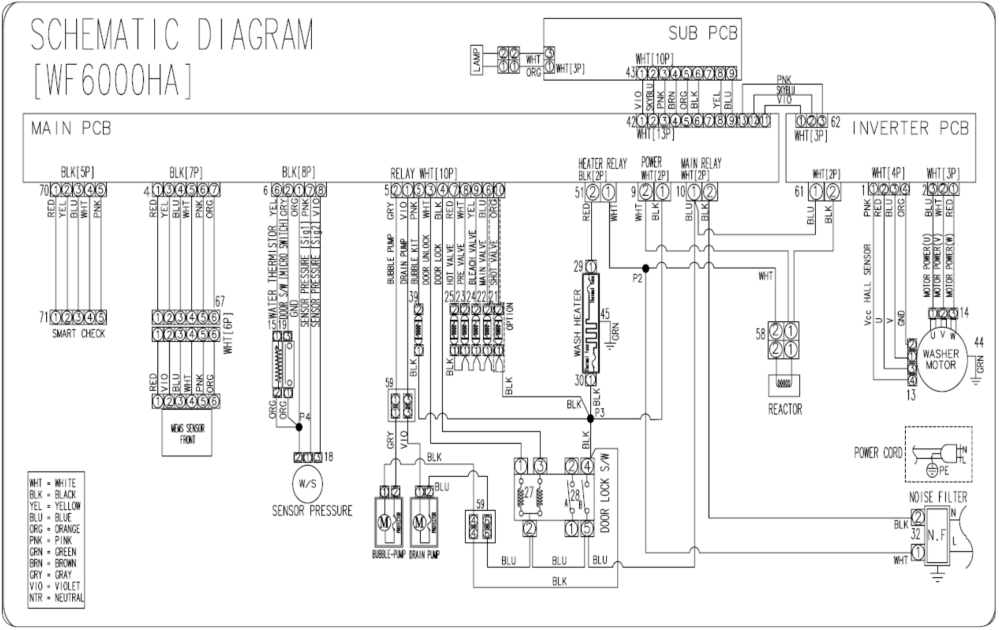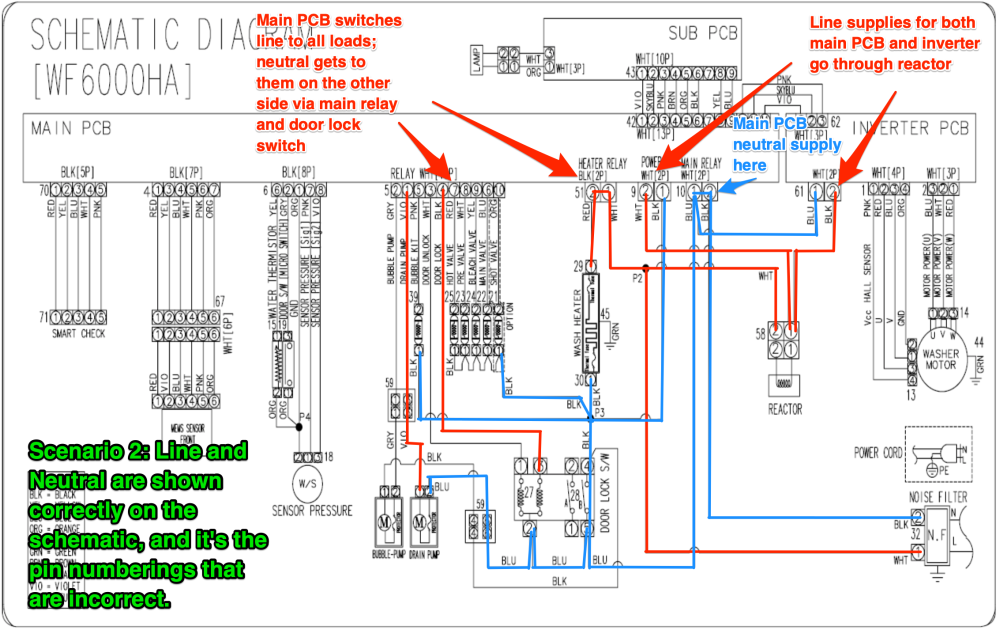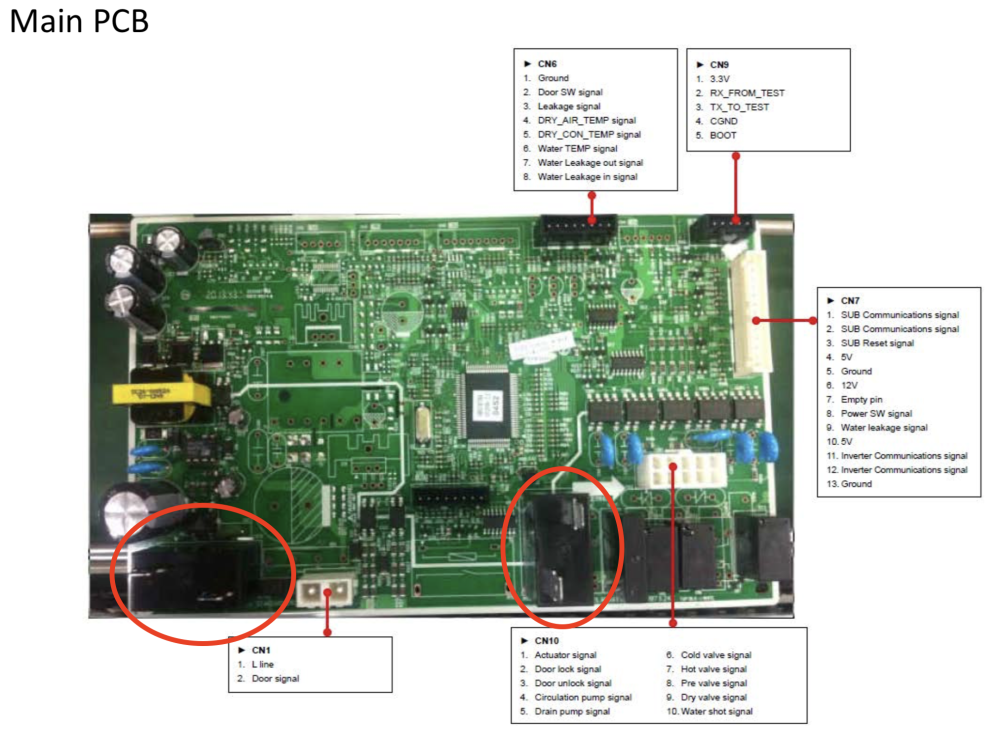An Odyssey Through Conflicting Information in a Samsung Washer Fast Track
Come on a journey with me as we explore just how tangled your circuit analyses can get when you're confronted with conflicting information in a tech sheet.
Here's the Samsung washer schematic we're working with:
Nothing crazy here -- this is pretty standard stuff to see on a Samsung schematic. But when it gets weird is when you try to trace out the power supplies of various loads and board on the schematic with the help of the pinouts elsewhere in the same tech sheet.
Here's the pinout for the main PCB -- pay special attention to the two-pin connector CN1. Supposedly, pin 1 is for Line, and pin 2 is for the "door signal".
What is the "door signal"? It's unclear at first glance. There's definitely a bit of Korenglish going on here, but if we look at the other connector pin labels, we can get a sense of what they mean by "signal". For example, CN10 pin 5 says "drain pump signal", and there are lots of other "signals" for other loads on that connector. It seems that they're using the word signal not to refer to data signals, but to refer to one leg of a load's power supply. Is it Line or Neutral? That's part of what we're trying to figure out...
This is more or less confirmed when you look at CN7, where they specify "communication signal" at multiple pins. That must be how they're calling out data signals.
Moving on, here's the pinout for the inverter board. Of particular interest is CN5, where the inverter supposedly receives Line on pin 1, and Neutral on pin 2.
Now that we've familiarized ourselves with the pinouts, we can put them together with the schematic to try to figure out a few things. Our primary questions are:
- How does the main PCB get its power supply?
- How does the inverter board get its power supply?
- Does the main PCB switch Line or Neutral to its loads?
Here's where we immediately start to hit some inconsistencies. First, the schematic shows three 2-pin connectors on the main PCB, but the pinout only gives information on one. So which of those three connectors are we given the pins for on the pinout? Furthermore, no matter how we start to trace out the circuits, we encounter inconsistencies in pin numbering.
I'm now going to present two possible scenarios for how these circuits could work. Each scenario has evidence in its favor, but each also requires you to decide that some pieces of information in the tech sheet are incorrect.
Presenting Scenario 1:
Here are the pieces of evidence for and against this scenario:
- On the inverter pinout, CN5 pin 1 is Line, and pin 2 is Neutral. In this scenario, the schematic and the pinout agree on that point.
- Wire colors match up with international standards (black for Line, white for Neutral) in this scenario
- In this scenario, you have to either disregard the main PCB's CN1 pinout, or you have to assume that that pinout applies to the Main Relay. But even if that were the case, the pin numbers are reversed -- according to the pinout, Line should be on pin 1, and the "door signal" should be on pin 2.
The circuits on this scenario work on paper. But is it the most likely layout, based on the information we have? Well, let's take a look at scenario 2.
The evidence for and against Scenario 2:
- We don't have to make the assumption that Line and Neutral are reversed on the schematic (and schematics are, as a general rule, the most reliable part of a tech sheet as far as technical information goes).
- Assuming CN1 on the main PCB pinout is referring to the Power connector on the schematic, the pin labels make sense -- though the numbering is reversed. As marked on the schematic in this scenario, CN1 pin 2 is the board's Line supply. Pin 1, on the other hand is our "door signal" -- which, contrary to how "signal" is used elsewhere in the pinouts, does seem to be an actual signal in the way we Americans would use the word. It's a Neutral sensing line that lets the board know when the door lock switch is closed.
- For this scenario to be the case, not only do we have to assume that the numbering of CN1's pins are reversed, but we also have to assume that the pin numberings on the inverter's CN5 connector are reversed.
In the end, I'm more convinced by scenario 2. The real kicker for me is when you take another look at the main PCB schematic and note that it has two unmarked relays. Those must be the Heater and Main Relays, meaning that CN1 has to be the connector marked Power on the schematic. And regardless of which way the numbering of the pins should be, scenario 1 simply doesn't line up with the actual inputs shown for that connector. Scenario 2 does.
In the end, we're left with a situation where neither scenario is fully supported by the information in the tech sheet, so we have to do the tech thing, engage brain, and weigh the evidence to determine which is more likely.
As I said, I'm convinced of scenario 2's validity. But maybe you've spotted something that I haven't -- feel free to discuss in the comments! Or even better, maybe one of you fine techs has already worked on this model in the field, and you can tell us what your meter measured at some of these contentious points to put this ambiguity to rest.
Want to learn how to fluently read schematics and use them to troubleshoot with ease? Click here to check out our Core Appliance Repair Training Course over at Master Samurai Tech.
-
.png) 7
7
-
 1
1










4 Comments
Recommended Comments